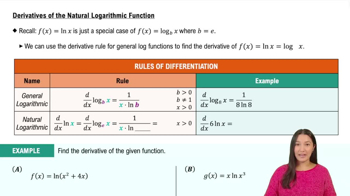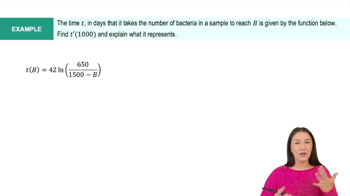Table of contents
- 0. Functions7h 52m
- Introduction to Functions16m
- Piecewise Functions10m
- Properties of Functions9m
- Common Functions1h 8m
- Transformations5m
- Combining Functions27m
- Exponent rules32m
- Exponential Functions28m
- Logarithmic Functions24m
- Properties of Logarithms34m
- Exponential & Logarithmic Equations35m
- Introduction to Trigonometric Functions38m
- Graphs of Trigonometric Functions44m
- Trigonometric Identities47m
- Inverse Trigonometric Functions48m
- 1. Limits and Continuity2h 2m
- 2. Intro to Derivatives1h 33m
- 3. Techniques of Differentiation3h 18m
- 4. Applications of Derivatives2h 38m
- 5. Graphical Applications of Derivatives6h 2m
- 6. Derivatives of Inverse, Exponential, & Logarithmic Functions2h 37m
- 7. Antiderivatives & Indefinite Integrals1h 26m
- 8. Definite Integrals3h 25m
6. Derivatives of Inverse, Exponential, & Logarithmic Functions
Derivatives of Exponential & Logarithmic Functions
Problem 3.9.65
Textbook Question
Calculate the derivative of the following functions. In some cases, it is useful to use the properties of logarithms to simplify the functions before computing f'(x).
y = (cos x) In cos²x
 Verified step by step guidance
Verified step by step guidance1
Rewrite the function y = (cos x)^(cos² x) using logarithmic properties to simplify the differentiation process. Take the natural logarithm of both sides: ln(y) = cos²(x) * ln(cos(x)).
Differentiate both sides of the equation with respect to x using implicit differentiation. Remember to apply the chain rule on the left side and the product rule on the right side.
On the left side, differentiate ln(y) to get (1/y) * (dy/dx). On the right side, apply the product rule to differentiate cos²(x) * ln(cos(x)).
For the right side, differentiate cos²(x) using the chain rule and ln(cos(x)) using the derivative of the natural logarithm, which involves the derivative of cos(x).
After differentiating, solve for dy/dx by multiplying both sides by y, which is (cos x)^(cos² x), to express the derivative in terms of y.
Recommended similar problem, with video answer:
 Verified Solution
Verified SolutionThis video solution was recommended by our tutors as helpful for the problem above
Video duration:
6mPlay a video:
Was this helpful?

 4:50m
4:50mWatch next
Master Derivatives of General Exponential Functions with a bite sized video explanation from Callie
Start learningRelated Videos
Related Practice














